I-25 (イ-25) was a B1 type (I-15-class) submarine of the Imperial Japanese Navy that served in World War II, took part in the Attack on Pearl Harbor, and was the only Axis submarine to carry out aerial bombing on the continental United States in World War II, during the so-called Lookout Air Raids, and the shelling of Fort Stevens, both attacks occurring in the state of Oregon.
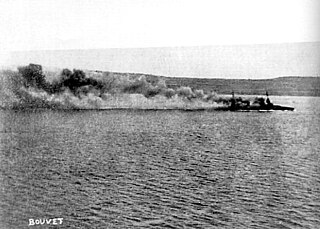
The naval operations in the Dardanelles campaign took place against the Ottoman Empire during the First World War. Ships of the Royal Navy, French Marine nationale, Imperial Russian Navy and the Royal Australian Navy, attempted to force a passage through the Dardanelles Straits, a narrow, 41-mile-long (66 km) waterway connecting the Mediterranean Sea with the Sea of Marmara and the Black Sea further north.

The 41st Infantry Division was an infantry division of the United States Army National Guard composed primarily of units from the Pacific Northwest. The division saw active service in World War I and World War II, receiving the nickname “Jungleers” during the latter.

Fort Stevens was an American military installation that guarded the mouth of the Columbia River in the state of Oregon. Built near the end of the American Civil War, it was named for Civil War general and former Washington Territory governor, Isaac I. Stevens. The fort was an active military reservation from 1863–1947. It is now listed on the National Register of Historic Places.

USS Pringle (DD-477), a Fletcher-class destroyer, was a ship of the United States Navy named for Vice Admiral Joel R. P. Pringle (1873–1932).

The Yokosuka E14Y was an Imperial Japanese Navy reconnaissance seaplane transported aboard and launched from Japanese submarine aircraft carriers such as the I-25 during World War II. The Japanese Navy designation was "Type 0 Small Reconnaissance Seaplane" (零式小型水上偵察機).
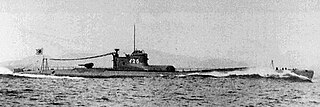
I-26 was an Imperial Japanese Navy B1 type submarine commissioned in 1941. She saw service in the Pacific War theatre of World War II, patrolling off the West Coast of Canada and the United States, the east coast of Australia, and Fiji and in the Indian Ocean and taking part in Operation K, preparatory operations for the Aleutian Islands campaign, and the Guadalcanal campaign, the Marianas campaign, and the Battle of Leyte Gulf. She was the first Japanese submarine to sink an American merchant ship in the war, sank the first ship lost off the coast of State of Washington during the war, damaged the aircraft carrier USS Saratoga (CV-3), sank the light cruiser USS Juneau (CLAA-52), and was the third-highest-scoring Japanese submarine of World War II in terms of shipping tonnage sunk. Her bombardment of Vancouver Island in 1942 was the first foreign attack on Canadian soil since 1870. In 1944, I-26′s crew committed war crimes in attacking the survivors of a ship she sank. She was sunk in November 1944 during her ninth war patrol.

From 31 May to 8 June 1942, during World War II, Imperial Japanese Navy submarines made a series of attacks on the Australian cities of Sydney and Newcastle. On the night of 31 May – 1 June, three Ko-hyoteki-class midget submarines, each with a two-member crew, entered Sydney Harbour, avoided the partially constructed Sydney Harbour anti-submarine boom net, and attempted to sink Allied warships. Two of the midget submarines were detected and attacked before they could engage any Allied vessels. The crew of M-14 scuttled their submarine, whilst M-21 was successfully attacked and sunk. The crew of M-21 killed themselves. These submarines were later recovered by the Allies. The third submarine attempted to torpedo the heavy cruiser USS Chicago, but instead sank the converted ferry HMAS Kuttabul, killing 21 sailors. This midget submarine's fate was unknown until 2006, when amateur scuba divers discovered the wreck off Sydney's northern beaches.
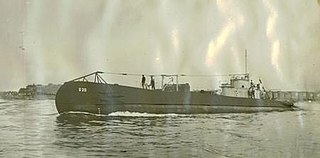
O 20, laid down as K XX, was a O 19-class submarine of the Royal Netherlands Navy that saw service during World War II. O 20 along with her sister ship O 19 were the first boats in the world to be equipped with a submarine snorkel that allowed the submarine to run its diesel engines while submerged.

The Lookout Air Raids were minor but historic Japanese air raids that occurred in the mountains of Oregon, several miles outside Brookings during World War II.

Fort Rodd Hill National Historic Site is a 19th-century coastal artillery fort on the Colwood side of Esquimalt Harbour,. The site is adjacent to Fisgard Lighthouse National Historic Site, the first lighthouse on the west coast of Canada. Both the fort and lighthouse are managed and presented to the public by Parks Canada.
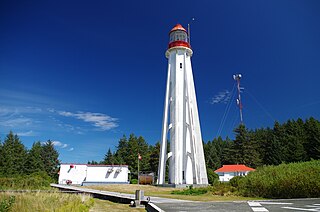
Estevan Point Lighthouse is located on the headland of the same name on the Hesquiat Peninsula on the west coast of Vancouver Island, Canada.
The Shelling of Newcastle was conducted by the Japanese submarine I-21 in the early hours of 8 June 1942. The bombardment followed the attack on Sydney Harbour on 31 May, and was conducted shortly after I-24 shelled the Eastern Suburbs of Sydney. During the attack I-21 fired 34 shells at Newcastle, including eight illumination rounds, but caused little damage. The Australian gunners at Fort Scratchley fired four shells at the submarine, but scored no hits.

A deck gun is a type of naval artillery mounted on the deck of a submarine. Most submarine deck guns were open, with or without a shield; however, a few larger submarines placed these guns in a turret.

The Bombardment of Ellwood during World War II was a naval attack by a Japanese submarine against United States coastal targets near Santa Barbara, California. Though the damage was minimal, the event was key in triggering the West Coast invasion scare and influenced the decision to intern Japanese-Americans. The event also marked the first shelling of the North American mainland during the conflict.

I-10 was an Imperial Japanese Navy Type A1 submarine that served during World War II. Designed as a submarine aircraft carrier, she was commissioned in 1941 and supported the attack on Pearl Harbor, operated in the Indian Ocean — including support for the 1942 midget submarine attack on Diego Suarez — and in the New Caledonia and New Zealand areas, and took part in the Guadalcanal campaign and Marianas campaign before she was sunk in 1944 during her seventh war patrol.
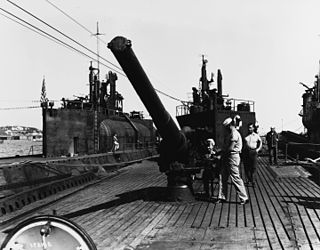
The 14 cm/40 11th Year Type naval gun was the standard surface battery for Japanese submarine cruisers of World War II. Most carried single guns, but Junsen type submarines carried two. Japanese submarines I-7 and I-8 carried an unusual twin mounting capable of elevating to 40°. The appended designation 11th year type refers to the horizontal sliding breech block on these guns. Breech block design began in 1922, or the eleventh year of the Taishō period in the Japanese calendar. The gun fired a projectile 14 centimeters (5.5 in) in diameter, and the barrel was 40 calibers long.
The shelling of Port Gregory took place on 28 January 1943 during World War II. The attack was conducted by the Japanese submarine I-165, under the command of Lieutenant Commander Tatenosuke Tosu, as a part of attempts to divert Allied attention away from the evacuation of Japanese forces from Guadalcanal, in the Solomon Islands. None of the 10 shells fired at Port Gregory caused any damage, and the attack was not noticed by the Allied naval authorities until a radio signal sent by Tosu was intercepted and decoded a week later.

SS Fort Camosun was a coal-burning 7000-ton freighter, built in Victoria, British Columbia, Canada in 1942. In June of 1942, during World War II, she departed Victoria Harbour on her maiden voyage to England with zinc, lead, plywood, timber and other raw materials. On 20 June 1942 the Japanese submarine I-25, under the command of Commander Akiji Tagami, torpedoed the Fort Camosun while she was 70 miles south-southwest of Cape Flattery, just eleven hours out of port, at 11:00pm. The torpedo hit the number two hold on the port side. The crew abandoned ship into the remaining good lifeboats. The submarine then surfaced and used deck guns to fire 18 shells at the Fort Camosun causing further damage to the ship. While badly damaged, the Fort Camosun did not sink, as she was loaded with plywood, timber and other floatable cargo. The crew radioed for help and later an American Flying Fortress located the crew. Later in the day HMCS Edmundston rescued the 31 crew of the sinking Fort Camosun. The Fort Camosun was towed to safety by HMCS Quesnel to Neah Bay. The Fort Camosun was low in the water and was towed with the help of the tugboat Henry Foss from Tacoma, US Navy tug USS Tatnuck and the tugboat Salvage Queen. Fort Camosun reached Neah Bay, later she was towed to Esquimalt B.C. At Esquimalt she was put in dry dock and temporary repairs were made. Fort Camosun repaired took timber to England, via Guantanamo and New York. On the way to England an U-boat attacked her convoy in the Atlantic. As she was passing through the North Channel alone a German aircraft tried to bomb her, but the bomb landed clear of the ship. Later she survived another torpedo attack in the Gulf of Aden.

SS Connecticut was a 8684 ton tanker ship built in 1938 by Bethlehem Shipbuilding Corporation and used for a World War II. She operated her under the United States Merchant Marine act for the War Shipping Administration, with United States Navy Armed Guards to man her deck guns. On December 28, 1941, the Connecticut was torpedoed near Cape Disappointment in the Pacific Ocean by I-25 of the Imperial Japanese Navy. To stop from sinking the Connecticut ran aground and was later salvaged. The attack took place 10 nautical miles off the mouth of the Columbia River near Oregon. The Japanese attack on the Connecticut was under the command of Lieutenant Commander Akiji Tagami.




















